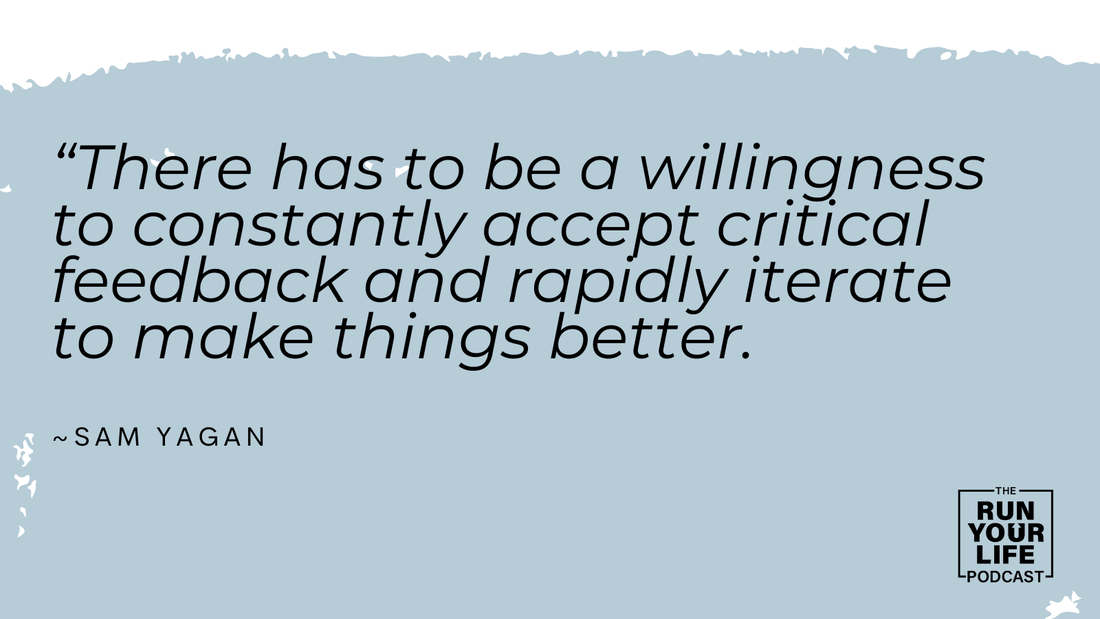|
A couple of years ago, I had the chance to interview the amazing Hall of Fame quarterback Anthony Calvillo on my Run Your Life Podcast. Anthony is the Canadian Football League’s all-time passing yardage leader and also the record holder for most touchdowns thrown in a career. During his brilliant 20-year career, Anthony Calvillo threw for almost 80,000 yards, including 455 touchdown passes. As a leader, Anthony had an enormous impact on his team. He led by example, learned from failure, and deeply committed himself to steady improvement over time. The legacy he left on his team, the Montreal Alouettes, will be forever etched into the fabric of that organization. Anthony Calvillo had always been a phenomenally gifted athlete. Yet, was he also a naturally gifted leader who demonstrated great leadership skills from the first time he stepped on the field to play professionally? In short, the answer is no. During our interview, Anthony reflected on early days in his career prior to playing for Montreal. At that time, he had been playing for the Hamilton Tiger Cats. Although he had established himself as the best quarterback on the team, he described himself as being overly confident in his abilities, unreceptive to critical feedback, unwilling to show vulnerability and lean on others for support, and too afraid to ask the questions needed to become better at his position. As a result, he lasted only two seasons with the Hamilton Tiger Cats and was ultimately cut by the team due to his lack of productivity and for repeating the same mistakes on the field that caused one poor performance after another. Being released by the team came as a shock to Anthony and gave him the wake-up call needed to do whatever was necessary to commit himself to true learning and growth. After he was cut, the Montreal Alouettes invited him for a tryout and the rest is history. He would go on to become one of the most outstanding quarterbacks in league history, winning three championships and multiple MVP awards. When I asked him how he had achieved all of this, he replied that being cut by Hamilton made him realize that he had to let go of his fear of failure and admit that he still had a lot to learn. When he got to Montreal, he was designated as the backup quarterback to then all-star quarterback Tracy Ham. Rather than feeling angry and disgruntled about not being the starting quarterback of the team, he devoted himself to being a learner. He actively chose to follow in the footsteps of Tracy Ham, so that he could be mentored by him. He and Tracy developed a very close relationship which allowed Anthony to learn from him and to blossom in his own way under his tutelage. During this time, he realized that he had never been open to feedback prior to going to Montreal because he didn’t want to be seen as someone who needed help. Anthony also admitted that, while playing at Hamilton, there was a lot he didn’t understand about the team’s offense, but he was too afraid of asking questions for fear of looking ‘stupid’ and ‘incompetent’. This all changed once he made the roster for Montreal. He began to ask questions about everything, so that he could better learn the game and the new offense he was playing in. He also sought as much critical feedback as possible from his coaches, Tracy Ham and fellow players about his performance, so that he could use it as a tool for improvement. In addition, he connected with teammates and built strong relationships by putting them first. Everything he did was about self-improvement so that he could be his very best, not only for himself, but also for his teammates. Once Tracy Ham retired, Anthony took over the starting role and held that position for 16 straight seasons, leading his team to one victory after another and multiple championships. In the process, he also became a transformational leader that led by example in order to inspire and empower his team around him to also strive for both personal and professional excellence. I use Anthony Calvillo’s story as a metaphor for what it takes to lead with authenticity, to build trust and engagement in the workplace and for any leader wanting to ultimately leave an enduring mark on their organization through their ability to drive long-term change. Great leaders have a transformative impact that extends far beyond their reach of immediate responsibilities. They intuitively know that honest and constructive feedback from their peers, subordinates and mentors must be prioritized, so that they not only know their strengths, but more importantly remain aware of their own shortcomings. These types of leaders know that a lack of feedback will negatively impact their own growth and improvement which will have a trickle-down impact on the entire organization. They ultimately know that everything starts at the top, therefore they must lead by example and model what it means to seek the feedback needed to continually improve and make the impact they desire. A 2020 report done by Deloitte’s Global Human Capital Trends found that only about 33% of leaders surveyed in their study reported that they regularly seek critical feedback from their peers and subordinates. Despite the fact that most leaders understand the importance of critical feedback, the majority of leaders, based on this study, avoid it. So, why might this be? A variety of research on leadership has identified that there are several common factors that contribute to why some leaders do not seek regular feedback, with the main factors being:
Although there are leaders who have colleagues in their organization complete general feedback surveys once or twice a year, there are times when not much is done with this data. Even though feedback data may be thoroughly analyzed with general findings being communicated to staff, this is oftentimes done in ways that does not reveal the whole truth, making it a much less efficient process. The most difficult thing here is to find the balance needed between gathering general feedback related to leadership on a whole, but also making it an expectation that every leader within the organization must also gather individual feedback as well. Determining the most efficient and effective process for gathering feedback that actually leads to growth, progress, and positive change can be very challenging for leaders to take action on. If you are a leader reading this, perhaps none of the 6 factors for ‘not seeking regular feedback’ apply to your own leadership journey or your organization. Seeking feedback may be a genuine strength and something you and your organization takes deep pride in. If so, keep doing what you’re doing as it models what it means to lead with authenticity in order to make everyone around you better. However, if you fall into the category of the 67% of leaders who don’t regularly seek critical feedback, know that you are not alone. Know that many other leaders out there also find it challenging to actively seek the feedback needed to honestly reflect on their own leadership. Whatever the reasons are for not making regular feedback a part of your own leadership journey doesn’t matter. What matters most is that you can always change your relationship with feedback. As the prominent American self-help author, motivational speaker, and spiritual teacher, Wayne Dyer, once said: “When you change the way you look at things, the things you look at change.” Changing the lens through which we look at progress and growth is critical in the process of transforming ourselves into the leader that our organizations truly need us to be. Bearing this in mind, any leader who struggles with seeking regular feedback might consider these four things: 1. Better Understand Your Impact Taking the time needed to reflect on your true impact in the workplace matters. The fact is that everyone in the organization usually pays close attention, whether consciously or subconsciously, to their leaders’ actions, words and ways of behaving. If leaders avoid getting the regular feedback needed to improve themselves and their organization, they may be directly responsible for creating an environment where employees feel unheard and undervalued. As a result, this can lead to lower morale and workplace engagement. Any leader who sincerely reflects on their impact, knows that they play a big part in the success or lack of success of the organization. Acknowledging that there is room for growth and improvement in their own leadership practice and taking the risks needed to seek honest and genuine feedback is a true game-changer for themselves and their organization. This alone should be enough to take more consistent action on making regular feedback a part of their leadership practice. 2. Start with One Question There are a multitude of ways feedback can be gathered. Many feedback protocols can easily be found by connecting with other leaders or doing your own search on the Internet. However, one of the best ways to start is by using one simple question: What is one thing you think I can do more of or less of to be more impactful as a leader? If you are beginning this process, you can start by asking this one question to those who you trust the most in the organization. From there, you can extend your reach by taking the chance to ask other people in the organization the same question. You can ask this question yourself face-to-face, you can send out an anonymous Google Form, or you can have someone you trust ask this question to others on your behalf. The fact that you are asking this question sends the message to everyone that you care and that you are actively seeking their feedback to better understand your impact and how you can improve. 3. Safety First When beginning to seek regular feedback, everyone must feel a sense of genuine safety in being able to answer feedback questions with honesty. This is especially the case when feedback is being delivered from subordinates to their direct line managers or senior leaders in the organization. Psychological safety is a critical part of the workplace environment as it encourages open communication, candor, risk-taking, and learning from mistakes. 4. Seek Coaching/Mentorship It is not necessary that leaders sit with critical feedback on their own. A lot of thinking needs to go into how to best process the feedback in a way that allows leaders to come out on the other side better for having sought the feedback in the first place. Sitting with a trusted colleague, coach or mentor is an important step in the process of gathering feedback, analyzing it, and creating an actionable plan related to how best to address the feedback in order to set relevant goals. A key element of this journey also requires being intentional about how leaders will communicate what they learned through the feedback and how they are addressing it. Being clear, concise, transparent and intentional about the feedback process with the colleagues in your organization enhances trust and sets a very positive tone. In the introduction of this article we looked at Anthony Calvillo’s story and how he took action to change his relationship with feedback. His extraordinary achievements were a direct result of his willingness to create the changes needed to not only pursue personal and professional excellence, but to also inspire his team to do the same.
Any leader reading this can do the same. However, it requires an objective evaluation of their current relationship with feedback and the extent to which they are truly modeling what it means to actively seek the feedback needed to improve themselves and their organization. Please share this article with any leader who you feel will benefit from reading it. Thanks!
0 Comments
Leave a Reply. |
AuthorKAUST Faculty, Workshop Leader, Presenter, Certified Cognitive Coach Archives
August 2023
Categories |



 RSS Feed
RSS Feed